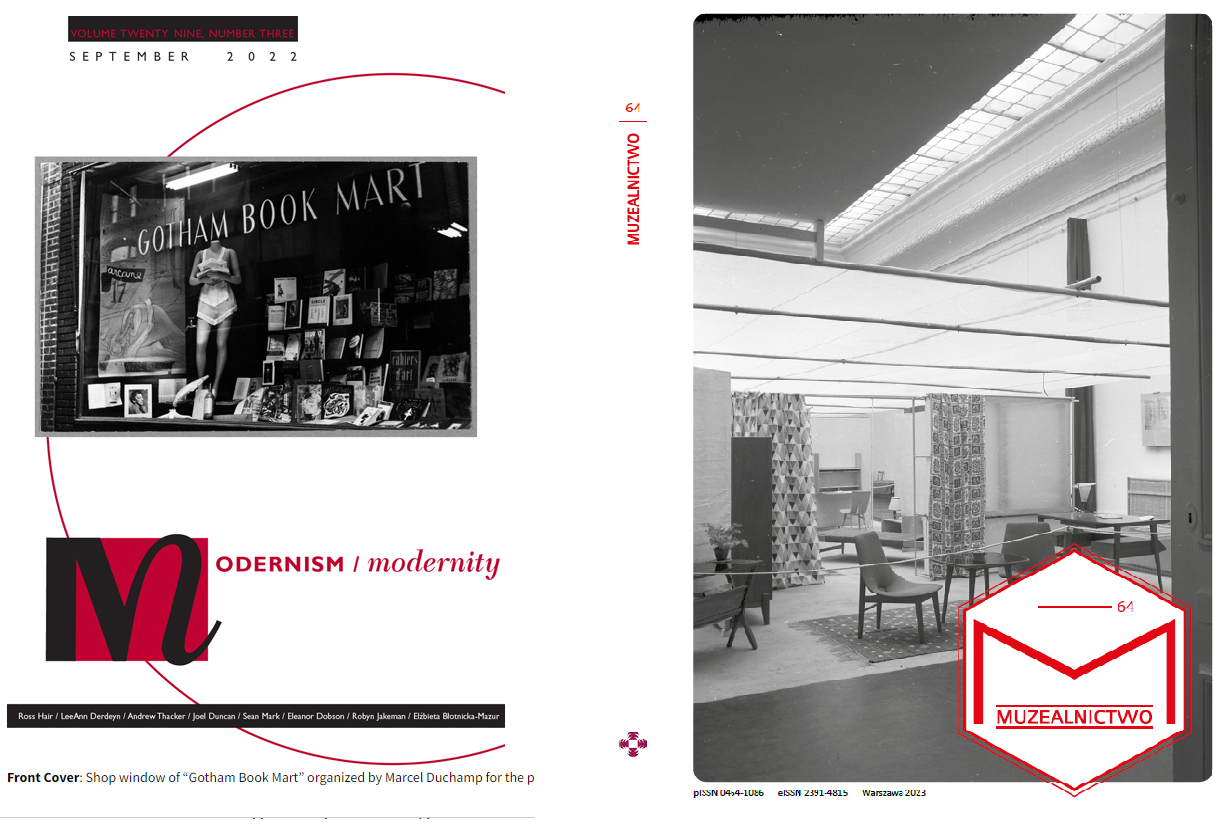

Participation of our Department Academic Staff in the Art History Open Day - 23 January 2025
All the academic staff of our Department, together with students of art history, participated in the organization of an Open Day for several classes of secondary schools in Lublin: C.K. Norwid Secondary School of Fine Arts and XXX rev. Jan Twardowski High School. The students participated in two different workshops, introducing them to the practical secrets of the work of an art historian. The museum workshop, using selected objects from the KUL Museum, was led by our colleagues from the Department also connected with the KUL Museum: Dr Elżbieta Błotnicka-Mazur, and Anna Szlązak-Nowak, MA, while the other group was introduced to the topic of alternative texts by Rafał Lis, MA, our specialist in the accessibility of art.

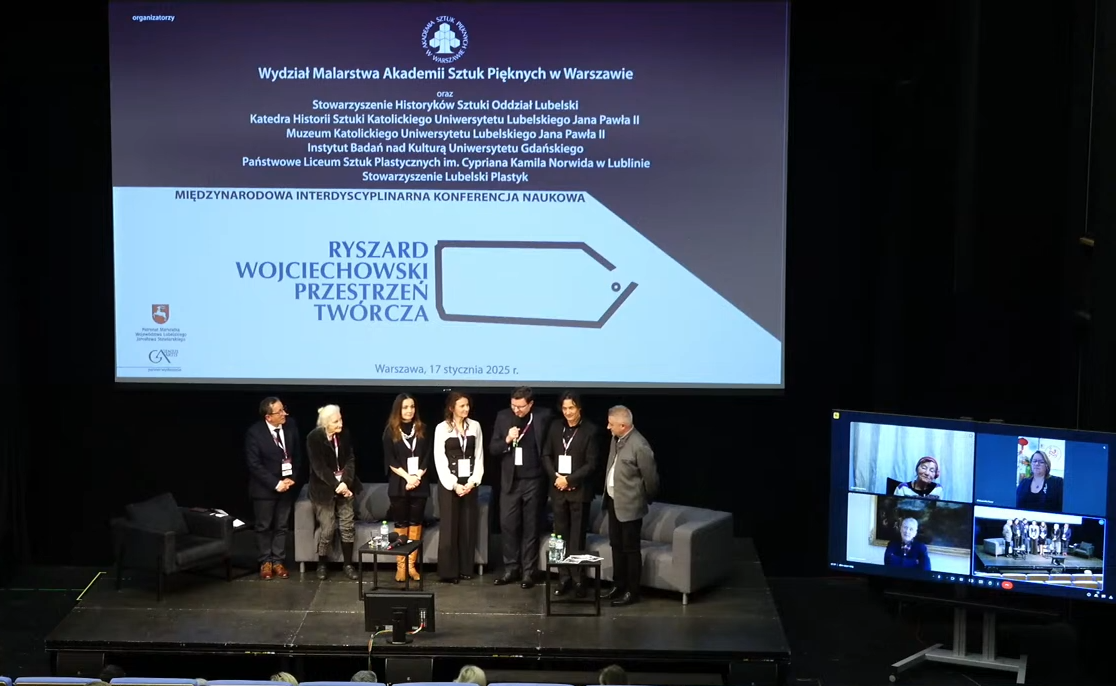
The latest issue of the journal ‘Folia Historiae Artium’, published by the Polish Academy of Arts and Sciences, features an article by Dr Anna Głowa, entitled ‘Wissenschaftlichkeit in Alois Riegl's study of Late Antique textiles from Egypt’. One of the most prominent representatives of the so-called Viennese school of art history, Alois Riegl (1858-1905), gained an important place in the history of our discipline, among other reasons, for the fact that, in dealing with works of art that were less well-known and unappreciated in his time, he was able to extract more information from their formal characteristics than anyone before, and thus contributed to laying the foundation for the independence of art history from other academic disciplines. This also applies to his work on Late Antique textiles from Egypt in the collection of the Imperial Royal Austrian Museum of Art and Industry (k.k. Österreichisches Museum für Kunst und Industrie). These were the subject of Riegl's first major publication, a catalogue compiled at the beginning of his career in the museum's textile department.
The aim of this article is to look at how Riegl sought to realise, in his research on this specific type of artefact, the postulates of scientism (Wissenschaftlichkeit) formulated by his teachers at the University of Vienna, and how, based on this research, he developed his original approach to works of art and art history.
This text and the other articles from this volume are available here:
https://pau.krakow.pl/FHA/FHA_22_2024.pdf

On 7 January 2025, a group of third-year art history students under the supervision of Dr Elżbieta Błotnicka-Mazur had the opportunity to visit several exhibitions in Warsaw museums . These included:
- the studio warehouses of 20th and 21st century sculpture and Xawery Dunikowski's sculpture collection at the Museum of Sculpture in Królikarnia (a branch of the National Museum in Warsaw);
- a large retrospective exhibition of Józef Chełmoński in the main building of the National Museum;
- and exhibitions at The National Ethnographic Museum, including the temporary exhibition “Two Souls of a Folk Artist”.

Dr Anna Dzierżyc-Horniak in the jury of the 11th edition of the Prof. Alicja Kępińska competition for the best MA thesis at University of the Arts Poznań
Dr Anna Dzierżyc-Horniak was a juror in the 11th edition of the Prof. Alicja Kępińska competition for the best MA thesis organised by the Magdalena Abakanowicz University of the Arts in Poznań. The winner was Blanka Grzybowska for her thesis entitled “Compost as an inspiration for curatorial practices”, whose supervisor was Prof. Marta Smolińska.

The latest issue of “Vox Patrum” features an article by Dr Anna Glowa, entitled 'The parrot motif in the mosaic decoration of the Church of the Holy Apostles in Madaba (578-579). In the church in Madaba, the floor of the nave is decorated with a parrot motif repeated dozens of times. There is a personification of the sea against the background of this pattern, accompanied by a dedicatory inscription beginning with the words “God, who created heaven and earth”.
The aim of the article is to attempt to answer the question of the significance of the parrot motif in such a context and the reason for its prominence by being multiplied over almost the entire surface of the nave.
The text and the other articles from this volume are available here:
https://czasopisma.kul.pl/index.php/vp/issue/view/584

![]()
Latest article by Dr Anna Dzierżyc-Horniak entitled ‘Artisti polacchi alla Galleria Arturo Schwarz di Milan’, in the monograph ‘Contatti artistici polacco-italiani 1944-1980. Anni “40 * Architettura * Arti visive”, edited by Jerzy Malinowski and Anna Jagiełło. The authoress takes a closer look at the context of the eponymous presence of Polish artists in one of the most famous European galleries of the 1960s and 1970s. She describes the exhibitions of photomontages by Mieczysław Berman (1973), reliefs and paintings from the years 1965-1974 by Henryk Stażewski (1974), and compositions by Ryszard Winiarski (1974), organised in Milan. Dzierżyc-Horniak presents these exhibitions as fitting well into the profile of the Arturo Schwarz gallery - a gallery presenting the most important works of the historical avant-garde and the most interesting achievements in its post-war history.
it is a aprt of conference proceedings of the international conference held at the Polish Institute in Rome (Istituto Polacco di Roma) in 2023.
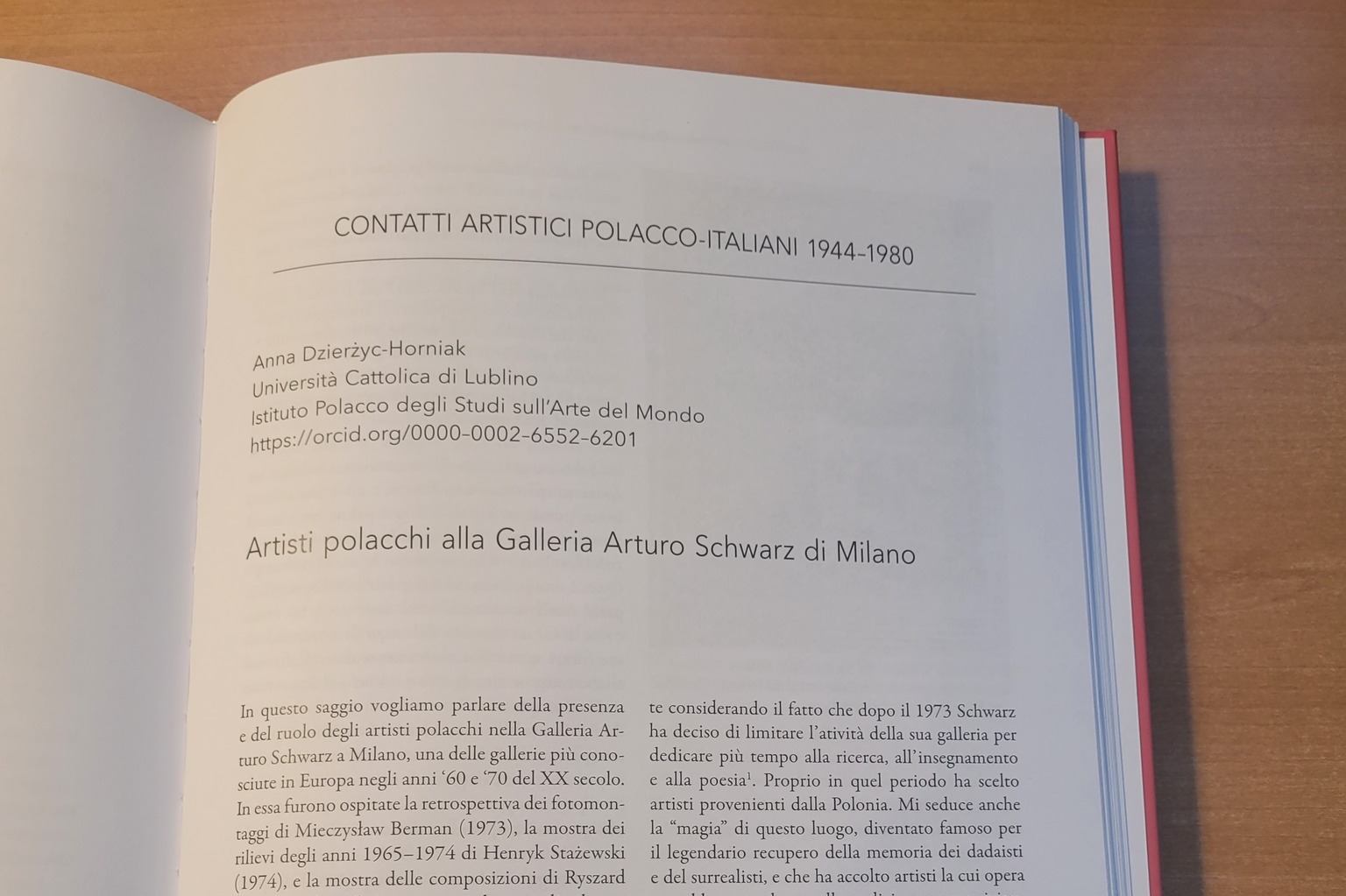
Dr Elżbieta Błotnicka-Mazur gave a lecture entitled ‘Sympozjum Artystów i Naukowców w Puławach 1966 - pochwała przemysłu vs działania protoekologiczne’ (‘Symposium of Artists and Scientists in Puławy 1966 - praise of industry vs. proto-ecological activities’, as part of the annual series of ‘Open Lectures in Art History’, which has been organised for several years by the Library in cooperation mainly with the lecturers and graduates of Art History at the John Paul II Catholic University of Lublin. This year's edition is held under the motto ‘Art and Nature. From Arcadian Myth to Deep Ecology’.
Dr. Błotnicka-Mazur discussed the most important assumptions of the Puławy symposium - it took place on the premises of Zakłady Azotowe in Puławy - which was intended by the organisers of the event to emphasise the integration of technology and art. However, she focused the audience's attention on the activities of those artists who have taken a stand for nature with their art, analysing, among others, the works of Jerzy Bereś and Liliana Lewicka, whose anti-technicist message was based on marking a clear opposition between destructive industry and nature, situating them in the circle of pro-ecological artistic manifestos.

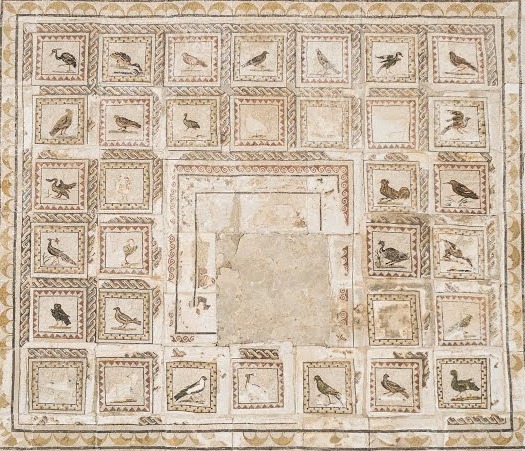
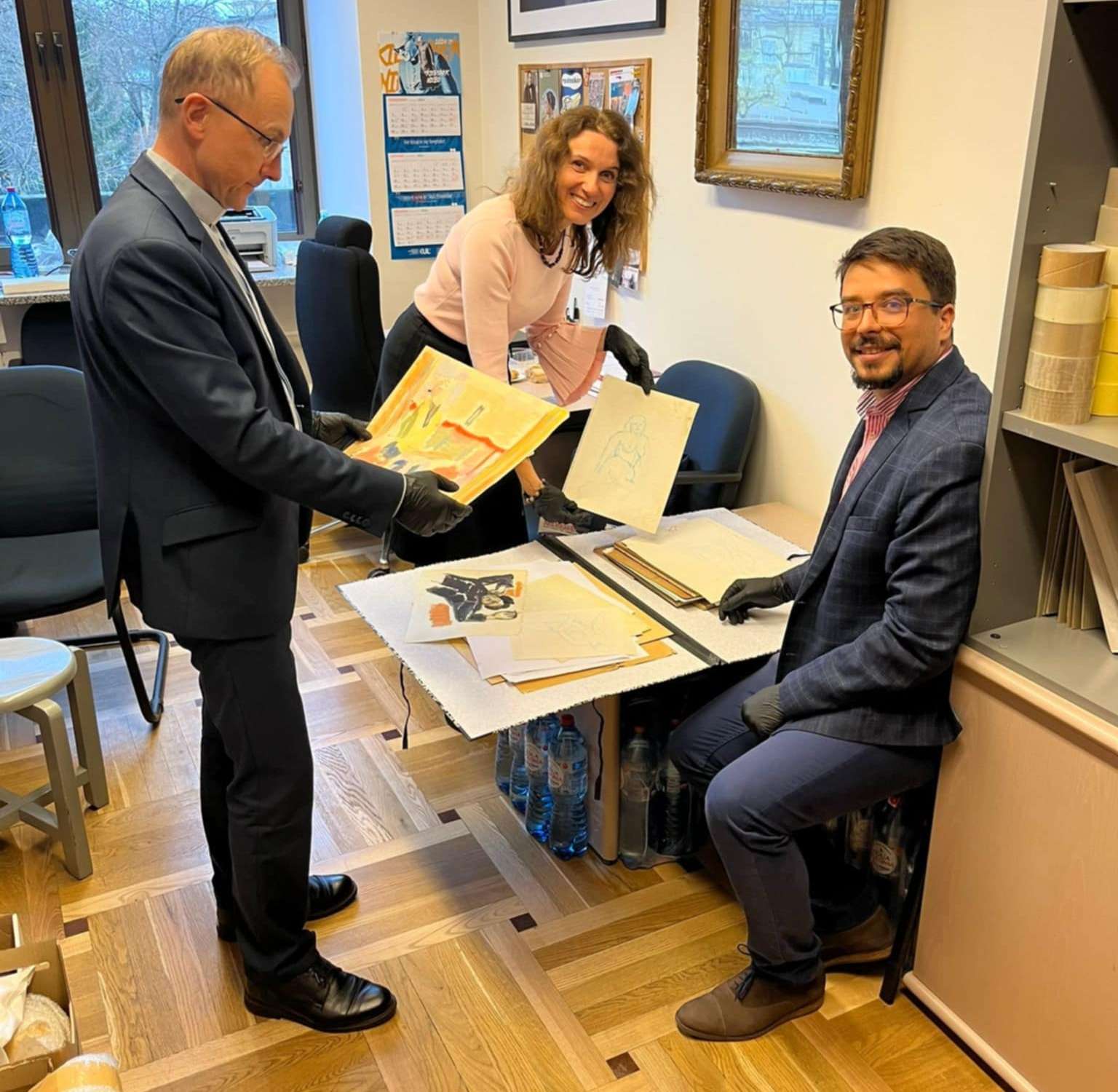
On the International Day of the Blind (13 November), we present a project by MA Rafał Lis, a lecturer from our Department: ‘EYE ON LUBELSKIE ART ENCOUNTERS’. It is a socially-created gallery of sculptural objects realised during Lublin Visual Arts Meetings in the 1970s. The project's website contains descriptions of all the objects that have survived to this day. The main aim of the project is to prepare audiodescriptions (textual descriptions) of selected objects.The project is available under the following link: www.okonalsp.wordpress.com
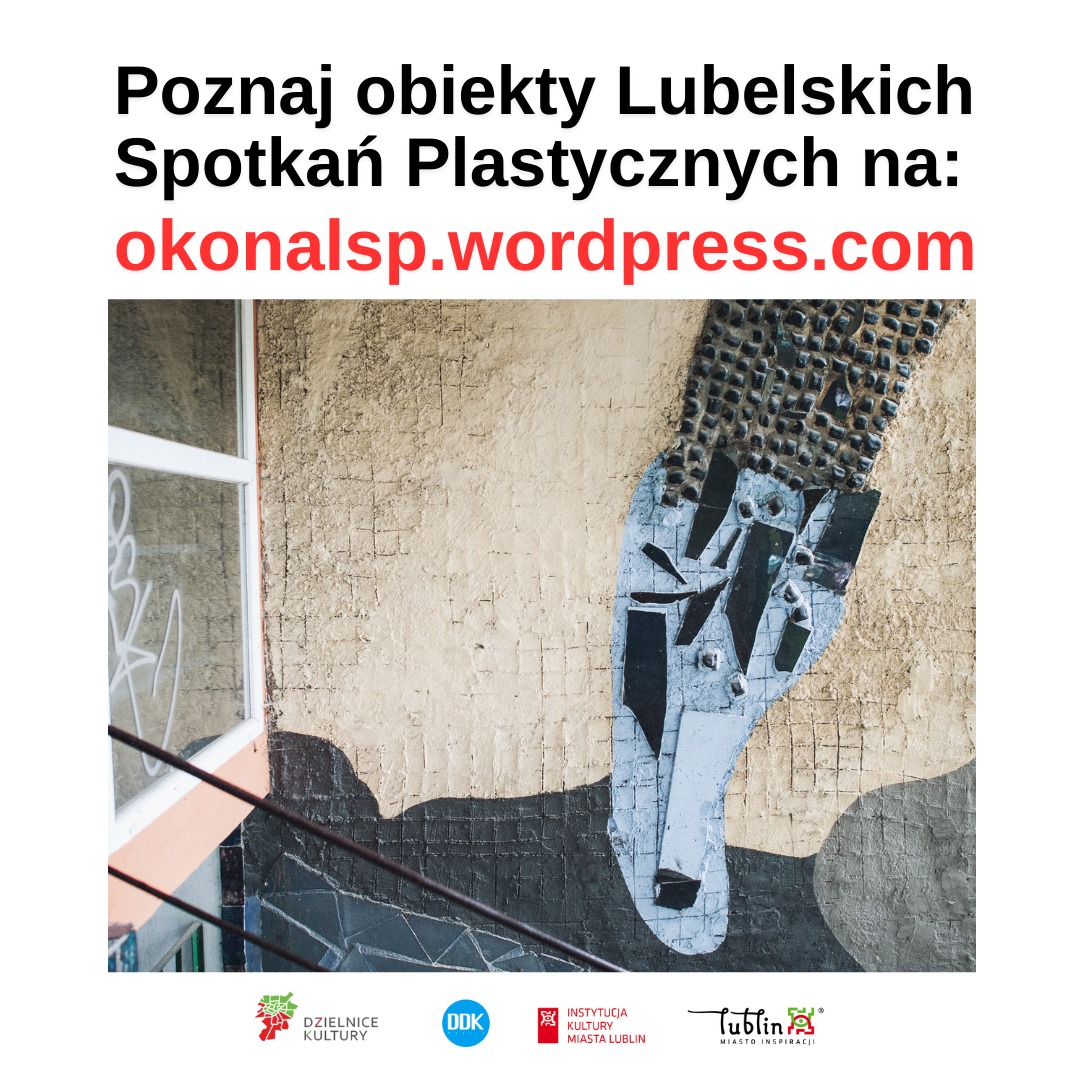
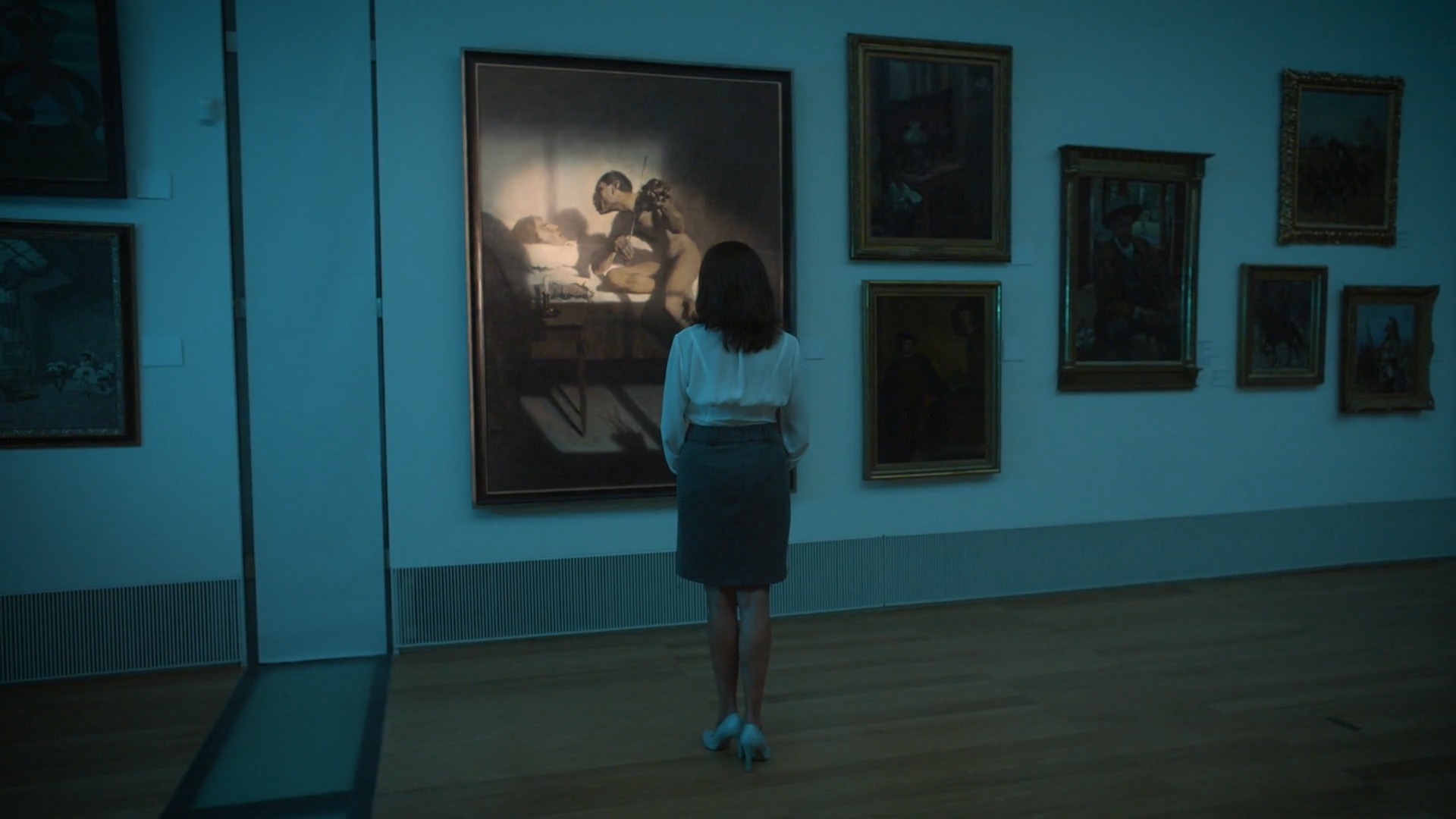
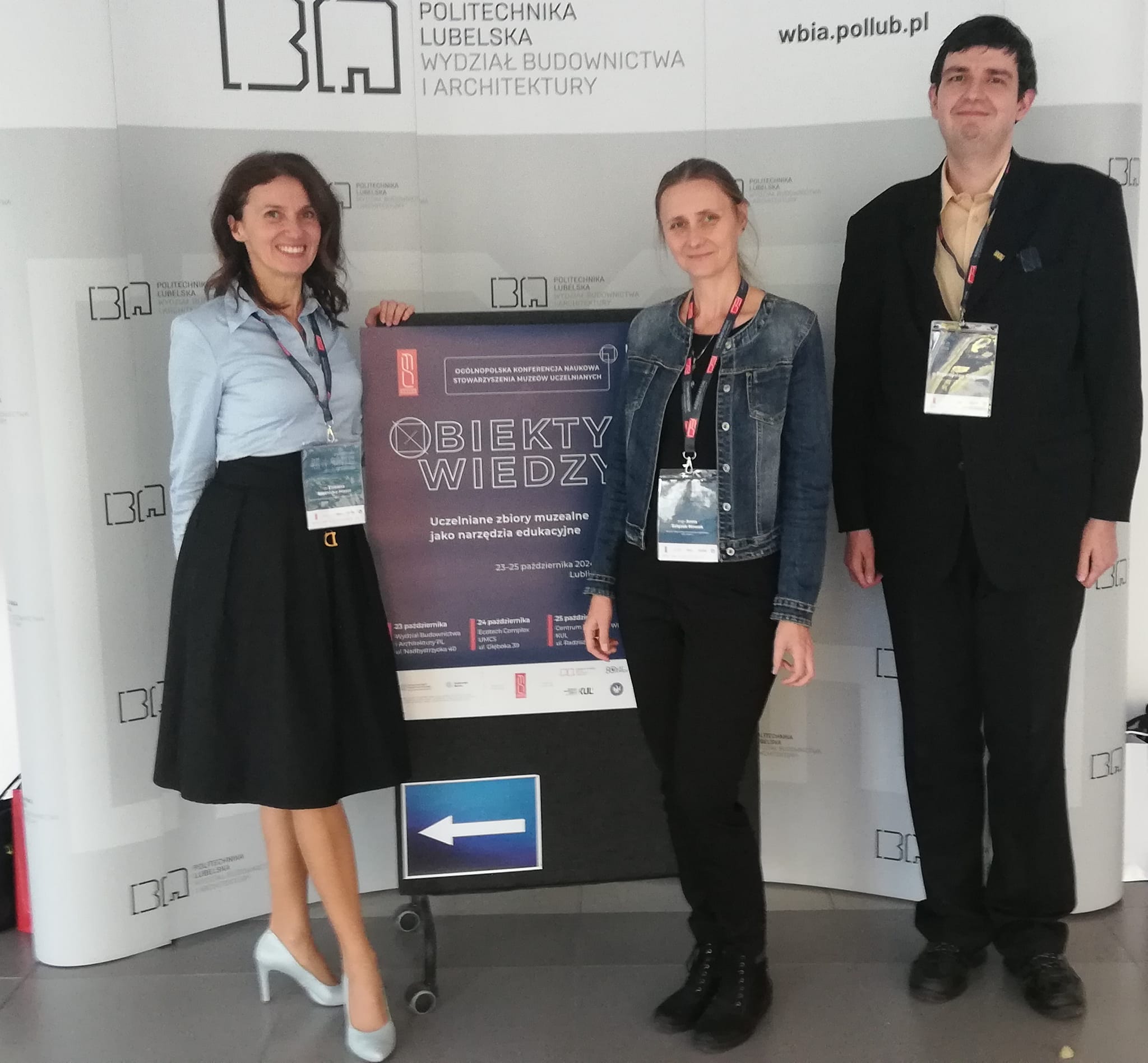
Dr Elżbieta Błotnicka-Mazur appointed as Director of the Museum of KUL
- 21 October 2024
We are pleased to announce that Dr Elżbieta Błotnicka-Mazur from our Department was appointed Director of the Museum of the John Paul II Catholic University of Lublin on 21 October 2024 by His Magnificence Rev. Prof. Mirosław Kalinowski, Rector KUL.
Congratulations!


Participation of Dr Elżbieta Błotnicka-Mazur and Dr Agnieszka Kuczyńska in the 16th World Congress of the IASS/AIS ‘Signs and Realities’ in Warsaw - 2-6 September 2024
From 2-6 September 2024, Dr Elżbieta Błotnicka-Mazur and Dr Agnieszka Kuczyńska actively participated in the 16th World Congress of the IASS/AIS ‘Signs and Realities’, in Warsaw, organised by the Faculty of Applied Linguistics of the UW, presenting papers in the panel ‘Semiotics and Artistic Realities’ by Prof. Małgorzata Gamrat from our Institute: ‘The codes of Adam Marczyński's ‘Variables’ in artistic reality’ (E. Błotnicka-Mazur) and ’The reality of ideas: Henryk Siemiradzki's allegorical paintings' (A. Kuczyńska).
Dr Elżbieta Błotnicka-Mazur also chaired one of the sessions ‘Semiotic and Artistic Realities’, while Dr Agnieszka Kuczyńska chaired the last panel of the congress ‘Pedagogy, Education, and Semiotics’.
An important event for art lovers was an individual visit to the Fryderyk Chopin Museum, organised by Dr E. Błotnicka-Mazur thanks to the kindness of Museum Director Dr Seweryn Kuter. Participants of the congress from Finland were invited for a special guided tour: the eminent pianist and musicologist Eila Tarasti, world-renowned semiotician and musicologist Prof. Eero Tarasti and his assistant Mikko Metsälampi, PhD student, whom we had the honour to host at KUL this year in March.
An event of great interest was a meeting with the editors of the world's most important journals covering semiotics and many other disciplines. Prof. Gamrat and Dr. Błotnicka-Mazur had the opportunity to present not only the latest special issue of the 'Roczniki Humanistyczne Annals of Art', (issue 12 musicology) and issue 4 (history of art), but also selected issues of other disciplines edited by researchers of the Faculty of Humanities at KUL.


Latest article by Dr Elżbieta Błotnicka-Mazur - May 2024
In the latest issue of "Rocznik Humanistyczne / Annals of Arts", vol. 72 (2024), issue 4: ‘Art and Reality. The reality of art', features an article by Dr Elżbieta Błotnicka-Mazur entitled: 'Architektura socmodernistyczna w Lublinie. Projekt nowego śródmieścia Lublina – studium przypadku' (eng. 'Socialist-modernist Architecture in Lublin and a Proposal for Lublin's New Downtown: A Case Study’ - abstract, pp. 305-331). In this paper the author presents the transformation of the development concept of the so-called new centre of Lublin in the period 1967-1975, the timeframe of which is determined by two events: an architectural competition in 1967 and the design of a shopping and service centre in 1975, not yet presented in the literature on the subject.
The article is available at the following link: https://hdl.handle.net/20.500.12153/7490
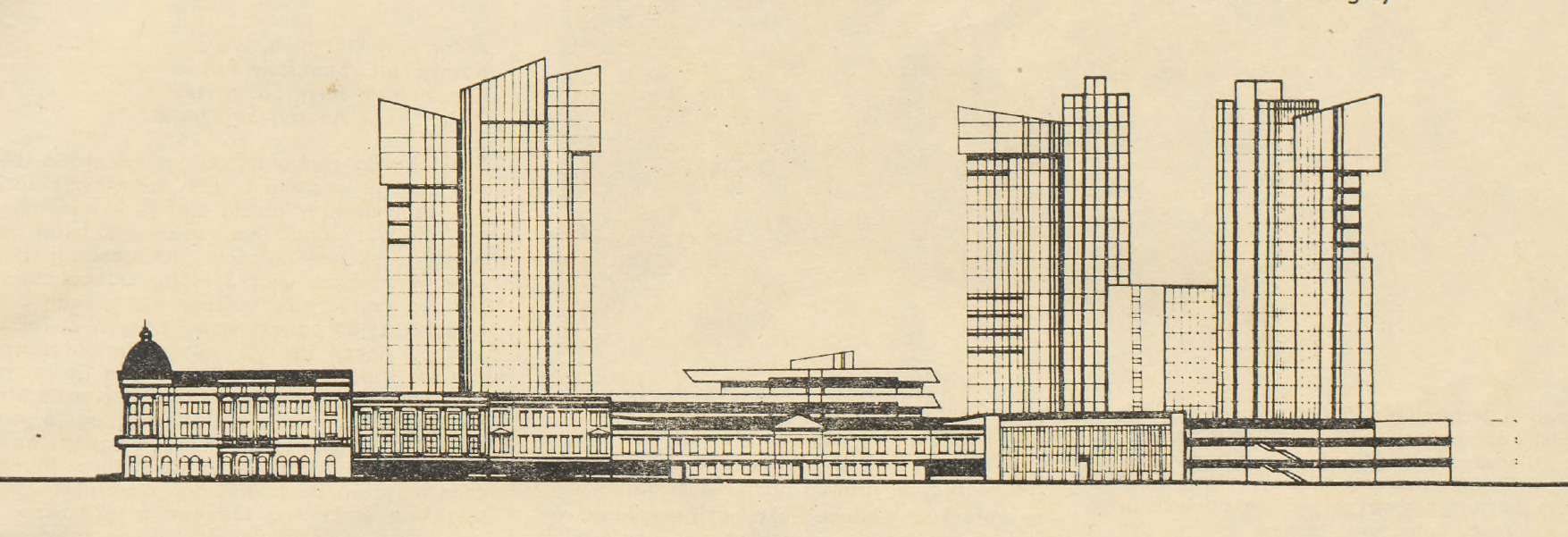
Project of a fragment of the new centre of Lublin, 1968, view from Krakowskie Przedmieście street, design by the team of the Zakład Planowania Miast i Osiedli of the Krakow University of Technology, after: Stanisław Juchnowicz, ‘Ze studiów nad centrum Lublina’, ‘Architekt’, vol. 23 (1969), no. 7, p. 253

Latest article by Dr Anna Głowa - May 2024
The latest volume of the journal ‘Studies in Ancient Art and Civilization’ features an article by Dr Anna Głowa entitled ‘A MOTIF OF PARROTS IN DIONYSIAN CONTEXTS ON SELECTED EXAMPLES OF HELLENISTIC AND ROMAN MOSAICS". Drawing on written and iconographic sources, the author argues that the parrot was integral to the visual language conveying ideas of earthly and eternal happiness, as well as the Hellenistic concept of tryphé.
The article is available at the following link:
https://journals.akademicka.pl/saac/article/view/5741/5402, and the entire SAAC volume here: https://journals.akademicka.pl/saac/issue/view/348
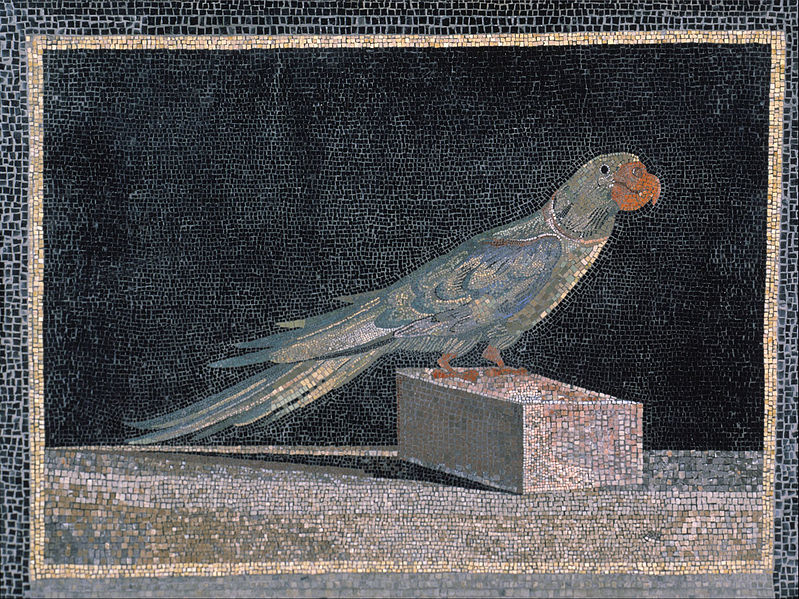

Participation of Dr Anna Głowa in the workshop ‘How to study an Egyptian textile collection?’ - Norway, 19-20 April 2024
On 19-20 April, Dr Anna Glowa is taking part in an international workshop at the Norwegian National Museum in Oslo entitled ‘How to study an Egyptian textile collection?’. Specialists from various fields: archaeologists, textile conservators, historians, art historians and museum curators deliberated on issues related to the history of late antique textile collections from Egypt, the analysis of raw materials and textile techniques, as well as deciphering the meanings of motifs used in the decoration of clothing and utility textiles - discussing them using examples from Scandinavian collections. Dr Anna Głowa also presented a paper on the nuances in the meaning of the eagle motif depending on the function of the textile decorated by this motif.
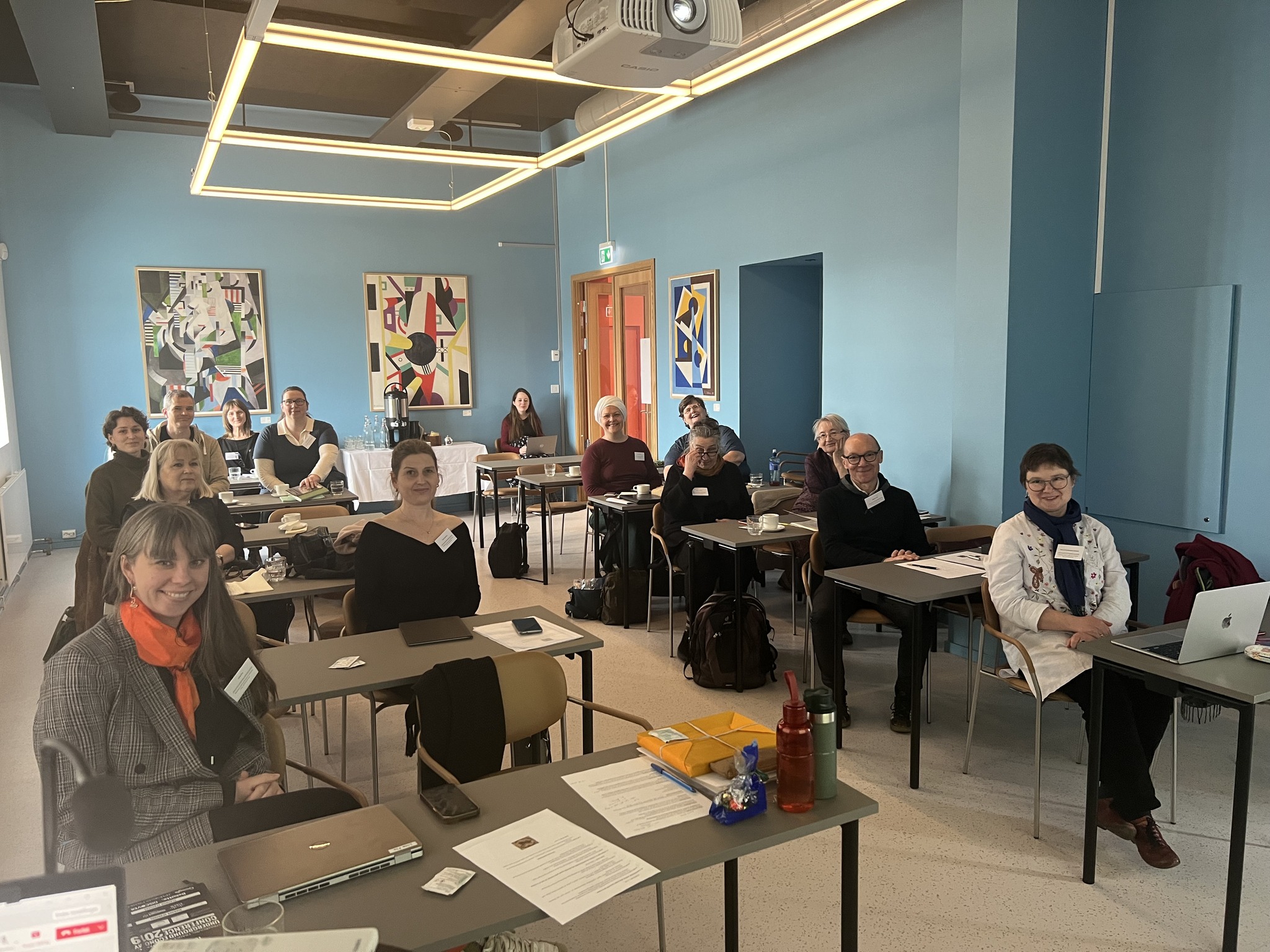

Dr Anna Dzierżyc-Horniak in the conference ‘Oblicza wody’ in Warsaw
- 14-15 March 2024
On 14-15 March, Dr Anna Dzierżyc-Horniak participated in the interdisciplinary conference ‘Oblicza wody' (eng. 'Faces of Water’, organisers: the Asia and Pacific Museum in Warsaw, the Polish Institute of World Art Studies and the Faculty of Arts and Culture Sciences at the University of Warsaw), presenting a paper entitled: 'Pomiędzy falami. Ekologia i duchowość wody na wybranych przykładach sztuki Azji' (eng. ‘Between the waves. The ecology and spirituality of water in selected examples of Asian art'). During her presentation, she juxtaposed two approaches in the use of the medium of water, as presented in her artistic practice by Jane Jin Kaisen, a Korean-born visual artist working in Copenhagen, and Su Yu Hsin, a Berlin-based artist from Taiwan. She evoked the world of haenyeo (women of the sea) and ocean-related shamanic practices from the Korean island of Jeju, as well as research related to the problematic nature of access to water using a Taiwanese semiconductor factory as an example. Dr Dzierżyc-Horniak reflects on the practices of both artists, bringing to the fore the theme of water as a source of life, memory, but also conflict and resistance.


Lectures by Prof. Eero Tarasti from Hesinki, visiting professor at the Institute of Arts Studies - 11-15 March 2024
From 11-15 March 2024, students of the Institute of Arts Studies are attending lectures by the world-renowned semiotician and musicologist, visiting professor at our university, Eero Tarasti (University of Helsinki, Academy of Cultural Heritages). The series, entitled ‘Semiotics and music. Theory and practice', aimed primarily at first-year Master's students, is interdisciplinary in nature. The lecture is attended not only by students of musicology and art history at the John Paul II Catholic University of Lublin, but also by interested students from other faculties.
The theoretical analyses are complemented by excerpts of music played live during the lectures by Professor Tarasti, as well as his wife, Eila Tarasti, an accomplished pianist. The Professor's assistant, Mikko Metsälampi, MA, also provides constant support. The guests from Finland attended a concert held as part of the ‘Encounters with French Music, Art and Culture’, organised by the Roman Filology, Art History and Musicology departments of our University.
The Professor's arrival was organised by Prof. Małgorzata Gamrat (KUL musicology), and the guests were also accompanied by Dr Elżbieta Błotnicka-Mazur from our Department and Rev. Dr Michał Jędrzejski (KUL musicology).
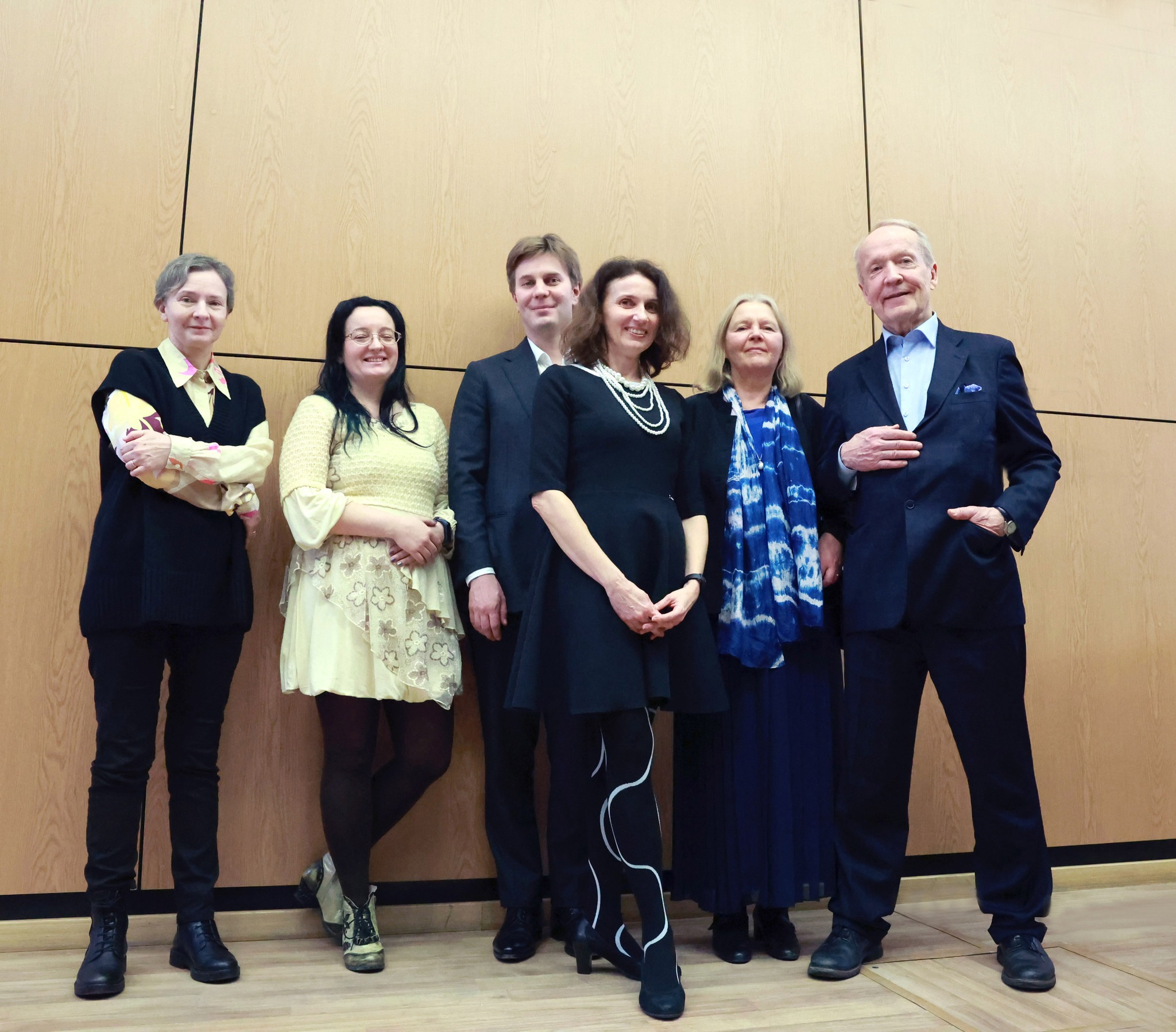

A volume of studies entitled ‘Dzieje Lubelszczyzny 1918-1939. Aspekty społeczne, gospodarcze, oświatowe i kulturalne’ [History of Lublin 1918-1939: Social, Economic, Educational and Cultural Aspects] [eds. Marcin Kruszyński, Tomasz Osiński, Robert Litwiński, Waldemar Kozyra, Dariusz Magier, Lublin-Warsaw 2023, 800 ss.], published by Instytut Pamięci Narodowej [the Institute of National Remembrance] constitutes a continuation of considerations on the political history of the Lublin region in the years 1918-1939, a research proposal rich in material showing the social, economic, educational and cultural issues of the region.
It includes two chapters devoted to the artistic life of Lublin and the Lublin region in the interwar period, authored by Dr Elżbieta Błotnicka-Mazur:
- 'Sztuki plastyczne. Instytucje – twórcy – dzieła [‘Visual arts. Institutions - artists - works’], pp. 622-634, and
- 'Sztuki plastyczne. Wystawy i krytyka' [‘Visual arts. Exhibitions and criticism'], pp. 635-644.
Dr Błotnicka-Mazur for many years has had architecture and art in the Lublin region in the twentieth century one of her areas of research interest. She analyses in both articles, in chronological order, the artistic, pedagogical, exhibition and critical activities of the artistic community of Lublin and the most important centres in the region. This synthetic overview shows that despite the fact that on the eve of Poland's independence Lublin was only a medium-sized provincial centre, the city was exceptionally fortunate in having personalities whose intense activity in the field of art significantly influenced its cultural development.
Table of contents of the publication: https://ipn.gov.pl/pl/publikacje/ksiazki/195546,Dzieje-Lubelszczyzny-19181939-Aspekty-spoleczne-gospodarcze-oswiatowe-i-kultural.html?fbclid=IwAR3o9dfSSkxlxLbQ6OpaOflpGavY8-_fjSY4oLGAkXoyFms2EScryeXRu3I


Latest article by Dr Anna Głowa
'Journal of the History of Collections' (Oxford University Press), presents an article by Dr Anna Glowa entitled 'An unknown collector of Late Antique textiles from Egypt: Carl Kallenberg (1825–1900) and his ‘Koptische Stoffreste’'. The article relates to the topic of the history of a collection of late antique textiles from Egypt belonging to a little-known 19th-century antiquities collector. Kallenberg's colourful account of the circumstances of his purchase of textiles from Bedouins soliciting tourists in Sakkara, published in 1890 in the journal "Der Sammler", reflects the changing perception of Late Antique textiles, and tracing the subsequent history of his collection allows us to add to our knowledge of the provenance of many textiles now in several European museums, Polish including.
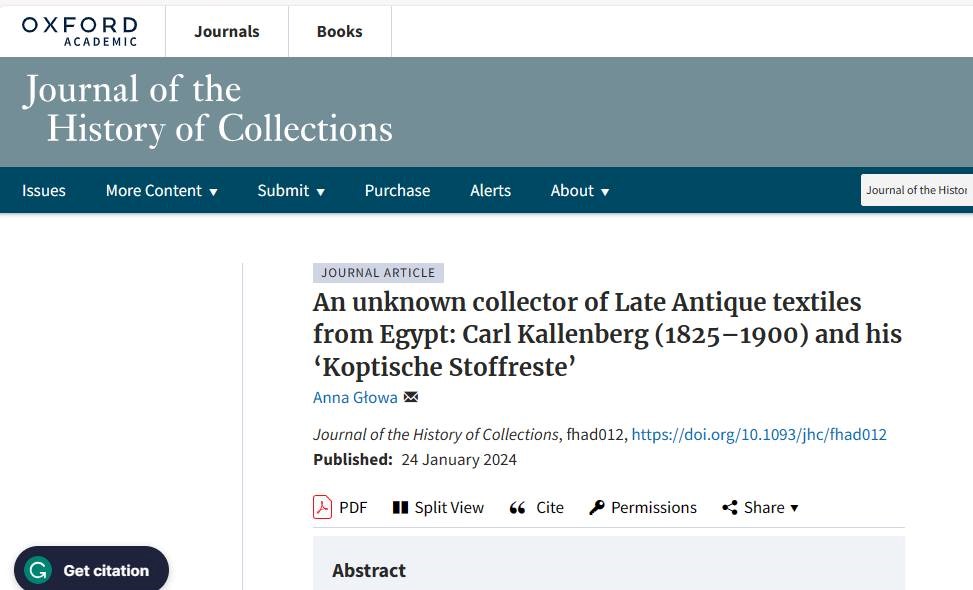

Latest article by Dr Agnieszka Kuczyńska
Latest article by Dr Agnieszka Kuczyńska entitled: ‘’Critical paranoia‘ as a surrealist variant of artistic thinking’, in 'Art Inquiry. Recherches sur les arts' (vol. 25 (2023): 'How do artists think?', pp. 115-125). The text deals with the concept of ‘critical paranoia’, which became an important impetus for Surrealist experimentation in the 1930s. Introduced by Salvador Dali, 'critical paranoia' was a tool that served to undermine a normative understanding of perception that was inadequate in the face of experience. In 'Anthologie de l'humour noir', Breton defined it as ‘the détournement of the logical function in its usual modes of operation’.
The article is available at the following link:: https://czasopisma.ltn.lodz.pl/Art-Inquiry/issue/view/422?fbclid=IwAR2cFzYoVToOH_uGVw2MmBN9YBq8XGk83bMrpe12F8Hw_uV0Sp1r_HGIAIE
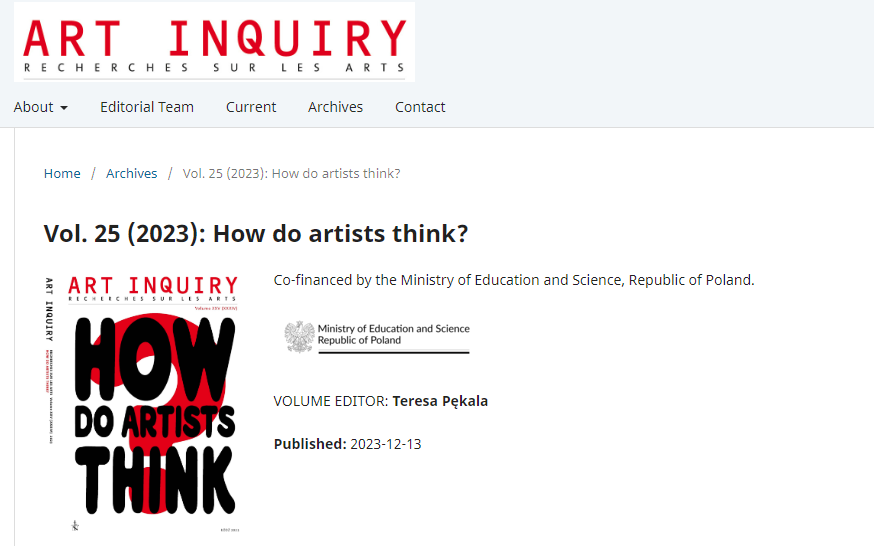

Rector's awards for Dr Elżbieta Błotnicka-Mazur and Dr Anna Głowa
In December 2023, the competition of the Rector of the John Paul II Catholic University of Lublin for the best-scoring publication in 2023 was settled.
We are pleased to announce that this year's two prizes in the discipline of arts studies were awarded to Dr Elżbieta Błotnicka-Mazur and Dr Anna Głowa from our Department!
Dr Elżbieta Błotnicka-Mazur received the award for the article entitled ‘Edward Krasiński's “Overhead Sculptures”. A Manifestation of Modernity', which appeared in the American journal Modernism/Modernity, vol. 29 (2022), no. 3 September, pp. 653-671, DOI: 10.1353/mod.2022.0025, published by the prestigious Johns Hopkins University Press. The author analyses spatial works from the 1960s from the series ‘Rzeźba napowietrzna’ (eng. 'Overhead Sculptures') by the Polish painter and sculptor Edward Krasiński (1925-2004), one of the most interesting protagonists of the Polish neo-avant-garde of the 1970s. The author used Julian Przyboś's critical and poetic essay 'Rzeźba napowietrzna' (‘Poetry’ 1966, no. 1, pp. 75-81) as an ideological context for her analyses.
Dr Anna Głowa was awarded for the article 'Historie w skrawkach tkanin. O proweniencji kilkunastu fragmentów późnoantycznych tkanin w muzeum Uniwersytetu Jagiellońskiego' [eng. ‘Histories in scraps of fabric. On the provenance of a dozen fragments of late antique textiles in the Jagiellonian University museum'], published in the journal 'Muzealnictwo', vol. 64 (2023), pp. 59-66, ed. National Institute of Museums, DOI: 10.5604/01.3001.0053.5980. The article addresses the importance of provenance research in situating objects of originally unknown provenance in a wider historical context, using the example of a little-known group of textiles from the collections of the Museum of Jagiellonian University in Kraków.
